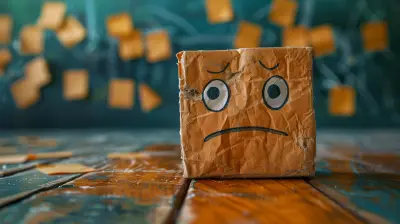Mastering Problem-Solving Skills for Real-World Challenges
20 June 2025
Problem-solving—it’s the secret sauce that separates the go-getters from the rest. Whether you’re decoding a tough math equation, navigating a workplace crisis, or simply figuring out the best route to avoid traffic, problem-solving is a skill you need in every aspect of life. But here’s the thing: most people never actively work on improving it.
That changes today.
If you want to tackle life’s challenges like a pro, you need a solid game plan. This article will show you how to master problem-solving skills so you can crush obstacles, think critically, and make smart decisions—no matter what comes your way. 
Why Problem-Solving Skills Matter More Than Ever
The world isn’t getting any simpler. Problems are coming at us from all angles—workplace dilemmas, financial struggles, personal conflicts, and even the everyday “What’s for dinner?” debate.Strong problem-solving skills don’t just help you survive; they help you thrive. Employers love candidates who can think on their feet. Entrepreneurs need it to take their businesses to the next level. Even in personal relationships, the ability to solve conflicts effectively can be a game-changer.
So, how do you level up this skill? Let's break it down. 
The Core Elements of Problem-Solving
Becoming a top-tier problem-solver isn’t about luck—it’s about strategy. Here are the core elements that make up effective problem-solving:1. Identifying the Problem
Sounds simple, right? Wrong. Many people confuse symptoms with the actual problem. Think about a leaky faucet. Is the problem really the dripping water, or is it faulty plumbing?To get to the root of the issue:
- Ask "Why?" multiple times. (This is called the 5 Whys Method)
- Look at the bigger picture. Sometimes, what seems like a personal failure is actually a system failure.
- Gather all relevant information. A problem well understood is a problem half solved.
2. Analyzing the Problem
Once you’ve pinpointed the issue, you need to break it down. This involves:- Understanding causes and effects. If X happens, then Y happens—what’s the link?
- Exploring different perspectives. Talk to people with different insights, because no one sees the full picture alone.
- Listing constraints. What obstacles could prevent a solution? Budget issues? Time limitations?
3. Brainstorming Solutions
Here’s where creativity kicks in. The best problem-solvers don’t settle for the first answer that comes to mind. They brainstorm multiple solutions before choosing one.Use techniques like:
- Mind Mapping: Write down the problem in the center of a page and branch out possible solutions.
- Reverse Thinking: Flip the issue. Instead of asking, “How do we attract customers?” ask, “What drives customers away?”
- SCAMPER Method: Substitute, Combine, Adapt, Modify, Put to another use, Eliminate, or Reverse aspects of the problem.
4. Evaluating and Choosing the Best Solution
Your list of solutions is useless if you don’t pick the right one. The best solutions are:✅ Effective: They actually solve the problem.
✅ Realistic: Can they be implemented given your constraints?
✅ Sustainable: Will they work in the long run?
Consider pros and cons for each option before making a decision. If in doubt, use a decision matrix—a simple chart weighing each solution against key factors like cost, time, and impact.
5. Taking Action
A solution on paper means nothing until it’s put into action. Take these steps:- Create a step-by-step plan. What needs to be done and by when?
- Assign responsibilities. If it’s a team effort, who’s handling what?
- Set deadlines. Otherwise, things will drag on forever.
6. Reviewing and Improving
Even the best-laid plans can go sideways. After implementing a solution:- Check if it actually worked. If not, why?
- Adjust if necessary. Sometimes you need to tweak things before getting the perfect result.
- Document your learnings. What worked well? What would you change next time?

Problem-Solving Techniques That Work Like a Charm
There isn’t just one way to solve problems. The best strategists mix and match different techniques to fit the situation. Here are some powerful methods you should have in your arsenal:1. The 5 Whys Technique
Perfect for identifying the root cause of any issue. Keep asking "Why?" until you uncover the real problem.Example:
- Why are sales down? → Customers aren’t buying.
- Why aren’t they buying? → The product is too expensive.
- Why is it expensive? → High production costs.
- Why are production costs high? → Inefficient materials.
- Why use those materials? → Lack of research on better alternatives.
Bingo! Now you know what to fix: research better materials.
2. Mind Mapping
This technique helps visualize possible solutions. Start with the main problem in the center and draw branches for different ideas.Example: Stuck in a creative block? Map out new inspiration sources—books, podcasts, brainstorming with friends, etc.
3. SWOT Analysis
Used by businesses, but equally useful for personal decisions. Break down your situation into:- S: Strengths (What’s working for you?)
- W: Weaknesses (What’s holding you back?)
- O: Opportunities (What could help you succeed?)
- T: Threats (What challenges might arise?)
4. Trial and Error
Sometimes, the best way to solve a problem is to test different approaches and learn from mistakes. This is especially useful in creative fields and entrepreneurship.5. The Eisenhower Matrix
Helps with prioritization. Draw a four-quadrant box:- Urgent & Important: Do these immediately.
- Important, Not Urgent: Schedule these for later.
- Urgent, Not Important: Delegate these to someone else.
- Neither Urgent Nor Important: Drop these entirely.

Common Problem-Solving Mistakes (And How to Avoid Them)
Even the smartest people fall into problem-solving traps. Here are common mistakes and how to avoid them:❌ Jumping to conclusions: Take the time to analyze before acting.
❌ Ignoring alternative solutions: Don’t settle for the first idea.
❌ Overcomplicating things: Keep it simple and practical.
❌ Trying to solve everything alone: Get input from others.
❌ Fear of failure: Failure teaches you better solutions. Embrace it.
Final Thoughts: Level Up Your Problem-Solving Game
Problem-solving isn’t just a skill—it’s a superpower. Whether life throws curveballs at you, or you’re aiming for success in school, work, or personal life, the ability to tackle challenges effectively sets you apart.The good news? Anyone can improve their problem-solving skills. It’s all about practice, patience, and persistence. Start small, apply these techniques, and watch your ability to solve life's puzzles like a boss skyrocket.
Ready to put these strategies to work? Go solve something today!
all images in this post were generated using AI tools
Category:
Skill DevelopmentAuthor:

Bethany Hudson
Discussion
rate this article
1 comments
Reagan McGuffin
This article brilliantly highlights the importance of mastering problem-solving skills in today’s world. The practical insights and engaging examples make it an invaluable resource for anyone eager to tackle real-world challenges with confidence. A must-read for learners everywhere!
June 23, 2025 at 10:49 AM

Bethany Hudson
Thank you for your kind words! I'm glad you found the insights valuable and relevant for real-world problem-solving.


